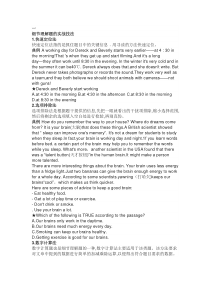 DOC
DOC
【文档说明】初中英语阅读理解解题技巧实战方法整理.docx,共(7)页,25.698 KB,由小魏子文库上传
转载请保留链接:https://www.ichengzhen.cn/view-200961.html
以下为本文档部分文字说明:
一细节理解题的实战技法1.快速定位法快速定位法指的是抓住题目中的关键信息﹐用寻读的方法快速定位。典例AworkingdayforDereckandBeverlystartsveryearlier——at4:30inthemorning!That'swhentheyge
tupandstartfilming.Andit'salongday—theyoftenworkuntil8:30intheevening.Inthewinterit'sverycoldandinthesummeritcanb
e40℃.Dereckalwaysdoesthat.andshedoesn'twrite.ButDerecknevertakesphotographsorrecordsthesound.Theyworkverywellasateam,andtheybothbelieve
weshouldshootanimalswithcameras——notwithguns!★DereckandBeverlystartworkingA.at4:30inthemorningB.at4:30intheaft
ernoonC.at8:30inthemorningD.at8:30intheevening2.选项排除法选项排除法是根据题干提供的信息,先把一眼就看出的干扰项排除,缩小选择范围,然后将剩余的选项填入空白处进行检验,辨别真伪。典例Howdoyouremembert
hewaytoyourhouse?Wheredodreamscomefrom?Itisyourbrain(大脑)thatdoesthesethings.ABritishscientistshowedthat“sleepcanimproveon
e'smemory”.It'snotadreamforstudentstostudywhentheysleep.Infact.yourbrainisworkingdayandnight.1fyoulearnwordsbeforebed.acer
tainpartofthebrainmayhelpyoutorememberthewordswhileyousleep.What'smore,anotherscientistintheUSAfoundthattherewasa“talentbutton(
天才按钮)”inthehumanbrain.Itmightmakeapersonmoretalented.Therearemoreinterestingthingsaboutthebrain.Yourbrainuseslessenergythanafridgel
ight.Justtwobananascangivethebrainenoughenergytoworkforawholeday.Accordingtosomescientists.yawning(打哈欠)keepsourbrains“cool”,whic
hmakesusthinkquicker.Herearesomepiecesofadvicetokeepagoodbrain:-Eathealthyfood.-Getalotofplaytimeorexercise.-Don'tdrinkorsmoke..Useyourb
rainalot.★WhichofthefollowingisTRUEaccordingtothepassage?A.Ourbrainsonlyworkinthedaytime.B.Ourbrainsneedmuchene
rgyeveryday.C.Smokingcankeepourbrainshealthy.D.Gettingexerciseisgoodforourbrains.3.数字计算法数字计算题也是细节理解题的一种,数字计算法主要适用于该类题。该方法要求对文章中提到的数据进行简单
的加减乘除运算,以便得出符合题目要求的数据。典例Whenwecutdowntherainforests,wedestroytheseforestpeople,too.In1900,therewere1,000,000forestpeopleintheAmazonforest.In1980,
therewereonly200,000.★ThenumberofthepeoplelivingintheAmazonforestin1980wasofthatin1900.A.halfB.one-thirdC.two-fifthsD.one-fifth二词义猜测题的实战技法1.通过构词
法猜测词义阅读中常常会遇到一些由熟悉的单词派生,转化或合成的新词,考生可以依据构词法方面的知识来猜测词义。典例Theylikedifferentkindsofamusements.TheGermansareveryhard-working.Theyli
ketidiness,especiallythewomen,whoalwayskeeptheirhomeclean.Whatdoestheunderlinedword“tidiness”meaninChines
e?A.整洁B.安静C.时尚D.随意2.利用标点符号猜测词义作者有时利用标点符号为一些生词直接提供定义或解释,这些符号无疑为考生理解或猜测生词词义提供了很好的线索,如破折号、引号等。考生在解题时要善于抓住这些线索。典例Bobworksinacarfactorynearhishom
e.Heworksveryhard.Heneedstowork8hourseveryday.Hewillbeonthenightshift—frommidnightto8a.m.nextday.★What'sthemeaningoftheun
derlinedwords?A.开夜车B.夜班C.熬夜D.晚上休息3.通过同义.反义关系猜测词义在生词所在的上下文中,有时会出现与之同义或反义的词语,这时可根据熟悉的词语的含义推知生词的含义。典例Initsfirsty
earofbusiness.DinersClubissued200cards.ThecustomerswhogotthecardsfromtheDinersClubcouldusethemat27differentrestaurants.Today.DinersCl
ubhasabout8millioncustomers.andtheycanusetheircardsinover7.6millionbusinessesinmorethan200countries.★Theunderlinedword“issued”hereprobablymeansA.sho
wedB.tookC.borrowedD.provided4.通过定义.解释和举例猜测词义在阅读材料中,特别是新闻报道及科普类说明文中,生词后面往往用thatis,mean,standfor,namely,referto,inotherwords等或破
折号引出说明性的内容,有时也用同位语、定语从句进行解释说明。还有些文章经常用例子来说明前面较难理解的词,这些例子可帮助考生准确猜测生词。文章举例时,常常会用一些连接词,如:suchas,like,forexample等。典例W
hydidhedoit?Whydidhebreakthelawandendangerpeople'shealth?Theanswerissimple:Hewantedtomakemoremoney.Itw
asamoralfailing,andthisisattheheartofthefoodscandalsinChina.Toomanypeoplefocusonmakingmoneyandnotontheeffectstheiractionscanhaveo
nothers.★Itwasamoralfailing,andthisisattheheartofthefoodscandalsinChina.Herewhat'stheChinesemeaningof"mo
ralfailing”?A.精神崩溃B.道德滑坡C.质量下降D.心理失衡5.根据释义猜词义释义常由定语从句或由is,or,thatis(tosay),inotherwords,becalled,beknownas等词汇短语或破折号来表示。典例Itwillbeveryhardbutalsoveryb
rittle—thatis,itwillbreakeasily.What'stheChinesemeaningof“brittle”?A.强壮的B.脆的C.骄傲的D.平静的6.通过上下文的联系猜测词义任何一篇文章中的句子在内容上都不是绝对孤立的,都与句子所在的段
落及整篇文章有联系。因此,考生可以利用上下文提供的情景和线索进行合乎逻辑的综合分析,进而猜测词义。典例Asshegrewolder.sheacceptedwhoshewas.Still.shewantedtofindthemissingpieceofthepuzzle.Afterfin
dingouttheplaceofherbirthparents.IdawenttoKoreain2008.Whenshefirstarrived,shewassurprisedtoseesomany
peoplewholookedlikeher.However,apartfromherlooks,notmuchcouldbesharedwithothers.sheknewlittleabouttheculture,food,especiallythelanguage.Beingin
Koreawasn'talwayseasyforher.★Whatdoesthephrase“apartfrom”mean?A.exceptB.asforC.aswellasD.besides三推理判断题的实战技法1.抓住特定关键信息进行正向或逆向推理考生做此类试题时
,要善于抓住某一关键信息﹐即某些关键词或短语去分析、推理、判断,利用正向推理或逆向思维,从而推断出这句话所隐含的深层含义。典例MarkWellmanshowedthatifyousetyourheartandmindonsomething,nowallistoohigh,andnodre
amisimpossible.Whatcanwelearnfromthepassage?A.Afriendinneedisafriendindeed.B.Dreamswillcometrueintheend.C.Eachstepisimportanttosuccess.D.Nothingcans
topastrongwill.2.根据文章中主人翁的所作所为推断主人翁的身份对于推断主人翁或作者身份的题目,考生要根据主人翁或作者的所作所为来推断。典例InEngland,everybodyknowsJamieOliver.HehashisownTVprogra
ms.Intheseprograms.hetellspeoplehowtocookhealthyfood.EveryonelikesJamie'sprogramsbecausehisfoodiseasytomake.Jamiewantsp
eopletoeathealthily.InsomeschoolsinEngland,thefoodatlunchtimewasn'thealthy.Oneday,JamiewenttoaschooltomakeaTVprogramabout
healthydiet.Hecookedthefoodwithlotsoffruitandvegetables.Atfirstthechildrendidn'twanttoeatbecausetheydidn'tlikefruitorvegetables.Butaftertheyta
stedthefood,theystartedtoenjoyit.Nowthefoodforchildreninschoolshasbecomemuchhealthier.★FromthepassagewelearntthatJamieisaf
amousA.TVhostB.filmactorC.schoolteacher3.运用语境的褒贬性进行信息推断有些文章的语境有一定的褒贬性,这种褒贬性反映了主人公的特定心理和情绪状态及作者的写作意图。
认真阅读原文并找出反映语境褒贬性及变化的标志性词汇或句子,对我们掌握文章主旨大意,了解主人公的心理特点及发展变化,从而正确地进行逻辑推断很有好处。典例Afterourhospitalvisit,myhusbandandlneededcheeringup.sowethoughtwew
ouldtreatourselvestoabigbreakfastatourfavouriterestaurant.Whilewewerewaitingforourmeals,wedecidedtousealloursmallchangeandmakeourwal
letslight.sowecounteditoutaswewaited.lvaguely(含糊地)rememberedseeingamansittingnearby.Whenourmealsarrived,wefoun
danote.Itread,"Yourbreakfasthasbeenpaidfor.Hopeyouhavealovelyday.”ltwasawonderfulsurpriseasnothinglikethathadeverhappen
edtous.Hemusthavethoughtwecouldhardlypaythebill.Welookedaroundtothankhim,buthehadleft.Asretirees(退休者),weweregratefulforthehelplikethis,butitwa
sthekindnessofatotalstrangerthatmeantsomuchmoretous.★ClearlythemansittingnearthecouplewasA.poorB.richC.helpfulD.grateful4
.根据上下文的逻辑得出结论逻辑结论是指严格根据文章中所陈述的事实、论点.例证等一系列论据材料进行推理,从而得出合乎逻辑的结论﹐而不是根据自己的经验、态度、观点或爱好去理解文章的内涵。做这类题时,应把握作者的写作思路,预测
下文可能发展的内容。文章可按事件发展的经过描写,也可按因果关系,对比关系来描写。典例MysummerholswrCWOT.B4,weused2go2NY2Cmybro.hisGF&.thr3:—@kidsFTF.ILNYanditsgr8.Canyouunderstandthissente
nce?Ifyoucan't,don'tfeeltoobad:neithercouldthemiddleschoolteacherinEnglandwhoreceivedthisashomework.ThisisNetspeak:thelanguag
eofcomputerizedcommunicationfoundonInternetorcellphones.Tonewcomers.itcanlooklikeacompletelyforeignlanguage.So,whatisthe“translati
on”ofthesentenceabove?Mysummerholidayswereacompletewasteoftime.Before,weusedtogotoNeeYorktoseemybrother,hisgirlfriend,andtheirthreescreamingkidsfa
cetoface.IloveNewYorkandit'sgreat.★Whatisthemainpurposeofthefirstparagraph?A.Togiveanexampleofaforeignlanguage.B.Toshowanexampleof
creativemethods.C.ToexpressworriesaboutusingNetspeak.D.ToleadinthetopicofNetspcak.四热身环节主旨大意题的实战技法1.主旨大
意题解题的“五大原则”主旨大意题是不能够从原文中直接找到答案的题目﹐解题时要注意以下“五大原则”:①以原文为依据,不掺杂个人意见,要客观不要主观。要克服“我认为……怎么样”的观点。②答案是比出来的。因为
,有时候四个答案都是对的。答案不选对的,只选最好的。比答案的原则是:好的≥不知道的≥不对的。③注意绝对化的词。如果答案选项中出现绝对化的词,比如:all.always,never,nothing,every等,除非文章当中使用了该类词汇,否则
,一般都要排除。④答案要避免以点带面,以偏概全。尤其是多个选项都有道理,难以挑选正确答案的时候,要注意选择最符合题目要求的一个。⑤“傻瓜”原则。文章中没有提到的就当是不知道,不要枉自猜测,自作聪明。一切以
文章内容为准。2.选帽原则所谓选帽原则,就是选的标题要像帽子一样,大小合适才行。另外,标题要简洁、突出、新颖。标题是文章的点睛之笔,所以它还要具有醒目的特点,能吸引读者。典例Hi,dearboysandgirl
s!Doyouknowhowtobeahealthykid?Herearesomerulesyoushouldfollow.First.eatdifferentfoods,especiallyfruitandvegetables.Youmayhaveafavouritefood,butyou'db
ettereatsomethingdifferent.lfyoueatdifferentfoods,youwillprobablygetmorenutrients(营养物质)yourbodyneeds.Second,drinkwaterandmilka
softenaspossible...Third.listentoyourbody...Fourth,limit(限制)screentimes...Fifth,beactive...Followtheserulesand
youcanbeahealthykid.★Whichisthebesttitleofthepassage?A.HowtobeactiveB.HowtomakeyourselfimportantC.Howtomakeyourparentshealth
yD.Howtobeahealthykid3.主题定位法主旨大意题主要包括两类;标题类和主旨大意类。这两类题目有很多的共性,解这类题目时,主要采取主题定位法。所谓主题定位法,就是通过分析文章的首尾和各段开头,找出每一小段的主题句,然后通过寻找共同点,找出整个文章的主题句。这种方法叫作主题定位法。要
掌握好主题定位法,考生要明白主题主要的呈现方式:(1)藏头露尾式藏头露尾式的意思是说,主题句不是出现在开头,而是出现在结尾。典例OntheInternet,wecanreadnewsathomeandabroadandge
tasmuchinformationaswecan.Weoftensende-mailsormaketelephonecallstoourfamiliesaswellastoourfriendsbyInter
net.what'smore,wecangotoschoolonthenet,readalotofbooksandeventeachourselvesforeignlanguages.Wealsoenjoymusic,watchballmatchesonthe
netandplaycomputergames.Withthehelpofthenet,wecandoshoppingevenwithoutleavingourhomes.TheInternetisplayingamoreandmoreimportantpartinourdailyli
fe.★What'sthemainideaofthepassage?A.KeepawayfromtheInternet.B.Surfthenet.C.TheInternetisplayinganimportantpartinourdailylife.D.Wecanenter
tainourselvesontheInternet.(2)首尾呼应式在有些文章中,为了突出主题,作者在文章开头提出主题,接着进行阐述或论证,在结尾时再次点明主题。值得注意的是,前后两个主题句不是简单的重复,再次出现的主题句往往是对前面主题句的进一步引
申或发展。典例Lacrosse(长曲棍球)isapopularsportinCanada.TheIndiansinCanadainventedit.Theyusedittotrainforwar.They
inventedthisgamebeforeColumbusarrivedintheNewWorld.Peopleplaylacrosseoutdoors.Thelacrossefieldissevenmeterslong.Ateachendofthefieldthereisagoal.Th
egoalis...TherearemanylacrosseclubsandlacrosseteamsalloverCanada.EverynightCanadianscanwatchthelacrossegamesonTVorlistentothelacrossegamesoverther
adio.AtonetimelacrossewasthenationalsummersportinCanada.TodayitisstillpopularwithCanadians.★ThepassageismainlyaboutA.howtoPlayLacrosseB.lacrossei
nCanadaC.theHistoryofLacrosseD.lacrosse—APopularGameinCanada(3)藏龙卧虎式藏龙卧虎式指的是主题句隐含在全文当中,没有明确的主题句。具体方法是:首先弄清楚各个段落讲了哪几个方面的内容,这些内容在逻辑上有什么联系,
寻找共同点,然后加以归纳形成主题。典例Handshaking.thoughaEuropeanpractice,isoftenseeninbigcitiesofChina.NobodyknowsexactlywhenthepracticestartedinEurope.Itissaidt
hatlonglongagoinEuropewhenpeoplemet,theyshowedtheirunarmedhandstoeachotherasasignofgoodwill.Astimewentonandtradeincitiesgrewrapid
ly,peopleincitiesbegantoclapeachother'shandstomakeadealortoreachanagreement.Thispracticewaslaterchangedintoshakinghandsa
mongfriendsonmeetingorleavingeachother.“Let'sshake(hands)onit!”sometimesmeansagreementreached.典例TheparagraphmainlytellsusA.wherehandshak
ingwasfirstpracticedB.howhandshakingcameaboutC.abouttherelationshipbetweenhandshakingandtradeD.aboutthepracticeo
fhandshakingbothinEuropeandinChina
 辽公网安备 21102102000191号
辽公网安备 21102102000191号
 营业执照
营业执照